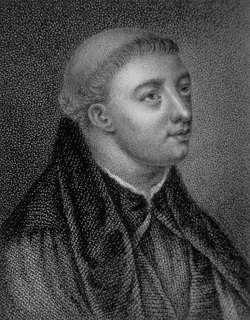 April 1 might be “April Fool’s Day,” but it is also (at least as of this year) “Whan That Aprille Day.” The name is drawn from the opening lines of the Prologue to the Canterbury Tales: “Whan that Aprille, with his shoures soote / The drogthe of March hath perced to the roote …. Than longen folk to goon on pilgrimages.”
April 1 might be “April Fool’s Day,” but it is also (at least as of this year) “Whan That Aprille Day.” The name is drawn from the opening lines of the Prologue to the Canterbury Tales: “Whan that Aprille, with his shoures soote / The drogthe of March hath perced to the roote …. Than longen folk to goon on pilgrimages.”
Not only is the phrase the beginning of one of the most famous works of English fiction, it is also—as is obvious—an example of a now-obsolete form of the English language (specifically, the London dialect of Middle English). Whan That Aprille Day is meant to celebrate and encourage the study of such old languages. The author of Geoffrey Chaucer Hath a Blog explains it this way:
Ower mission ys to remynde folk of the beautye and grete lovelinesse of studyinge the wordes of the past. And eke ower mission ys to bringe to mynde the importaunce of supportinge the scolership and labour that doth bringe thes wordes to us. To remynde folk to support the techinge of paleographye and of archival werke and eek, ywis, the techinge of thes oold langages. To remynde folk of the gret blisse and joye of research libraryes. For wythout al of thes, the past wolde have no wordes for us.
All wise words with which I agree. In honour of the day, I’d like to share a little bit of John Lydgate’s poetry with you all. Lydgate was a monk and poet who lived in the late 14th through early 15th centuries. He was a celebrated writer in his own time but is little remembered today. [By chance, The Guardian and BBC News have run stories about him in the last few days.]
I’m sharing with you a selection from his Legend of St. George. The tale, as we enter it, has advanced thus: A dragon has taken up residence near the Libyan city of Lysseene. In order to placate the monster, the people send out to it two sheep daily. But when the people begin to run out of sheep, the city is put in a difficult situation. How shall they feed the creature and prevent it from attacking? Eventually, they decide to draw lots to send their own people—“man or chylde”—out as food for the dragon. As Lydgate writes, “Allas, ellas, it was to gret pytee / To seen the sorowe that was in that citee.”
One day the lot falls to the King’s daughter. And as “the statuit made noon excepcyoun / Of heghe ne lowe,” she prepares to leave upon her fatal journey. Grief consumes the city: “Hir fader wepte, hir moder, boothe tweyne, / And al the cytee in teers did so reyne.” But on the way to the dragon, she meets a knight, whom she warns to flee lest he also be devoured. But this is St. George, and Lydgate tells us he has been “sent frome the Lord as in hir diffence / Ageynst the dragoun to make resistence.” He is moved by the woman’s plight and decides to save her if he can.
Lydgate continues:
Hooly Seint George his hors smote on the syde
Whane he the dragoun sawe lyft up his hede,
And towardes him he proudely gan to ryde
Ful lyche a knight with outen fere or dreede;
Avysyly of witt he tooke goode heed,
With his spere sharp and kene egrounde
Thoroughe the body he gaf the feonde a wownde.
The cely mayde, knelyng on hir kne,
Unto hir goddes maked hir preyer,
And Saint George, whane he did it see,
To hir he sayde, with debonayre cheer,
“Ryse up anoon, myn owen doughter deer,
Take thy girdell, and make therof a bande,
And leed this dragoun boldly in thyn hande
“Into the cyté, lyche a conqueresse,
And the dragoun meekly shall obeye.”
And to the cytee anoon she gan hir dresse,
The ouggely monstre durst it not withseye,
And Saint George the mayden gan conveye,
That whane the kyng hade inspeccyoun,
With palme and banner he goothe processyoun,
Giving to him the laude of this victorye,
Which hathe theyre cytee delyverd out of dreed;
And Saint George, to encresce his glorye,
Pulled out a swerde and smote of his hed,
The people alwey taking ful goode heed,
How God this martyr list to magnefye,
And him to enhaunce thorughe his chivallerye.
Thanne he made the dragoun to be drawe,
With waynes and cartes fer out of the towne,
And after that he taught hem Crystes lawe,
By his doctryne and predicacyoun,
And frome th’errour by conversyoun,
He made hem tourne, the kyng and the cyté,
And of oon hert baptysed for to be.
As we see, then, St. George not only frees the people of Lysseene from their physical captivity, he further frees them from their spiritual captivity. The people hear the Good News of Christ and are converted from Paganism. Thus it is that the physical dragon’s downfall at St. George’s hands anticipates the city’s spiritual salvation from “the dragon, that ancient serpent, who is called the devil and Satan” (Revelation 12:9).
To read the rest of Lydgate’s Legend of St. George (and for explanatory notes and glosses), visit TEAMS Middle English Texts.
———————



 April 1 might be “April Fool’s Day,” but it is also (at least as of this year) “Whan That Aprille Day.” The name is drawn from the opening lines of the Prologue to the Canterbury Tales: “Whan that Aprille, with his shoures soote / The drogthe of March hath perced to the roote …. Than longen folk to goon on pilgrimages.”
April 1 might be “April Fool’s Day,” but it is also (at least as of this year) “Whan That Aprille Day.” The name is drawn from the opening lines of the Prologue to the Canterbury Tales: “Whan that Aprille, with his shoures soote / The drogthe of March hath perced to the roote …. Than longen folk to goon on pilgrimages.”

